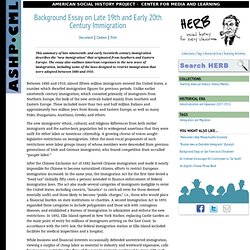

The Chinese Immigrant is Squeezed by Both Parties. The Chinese Immigrant is Squeezed by Both Parties In this political cartoon, the leaders of both political parties, James Garfield of the Republicans and Winfield S.
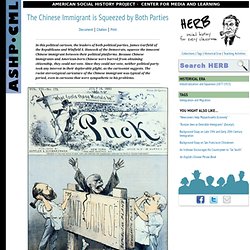
Hancock of the Democrats, squeeze the innocent Chinese immigrant between their political platforms. Because Chinese immigrants and American-born Chinese were barred from obtaining citizenship, they could not vote. Since they could not vote, neither political party took any interest in their deplorable plight, as the cartoonist suggests. The racist stereotypical caricature of the Chinese immigrant was typical of the period, even in cartoons that were sympathetic to his problems. View High-resolution Where both platforms agree--no vote--no use to either party Source | J.A. A Cartoonist Depicts "The Usual Irish Way of Doing Things" A Cartoonist Depicts "The Usual Irish Way of Doing Things" A bestial Irishman, his anger inflamed by pro-Irish political broadsides and "demon rum," represents a veritable powder keg of potential violence in this 1871 Thomas Nast cartoon.

The Day We Celebrate. The Day We Celebrate This cartoon by Thomas Nast depicts a riot that took place on March 17, 1867 in New York City between Irish immigrants and the Metropoliton Police.
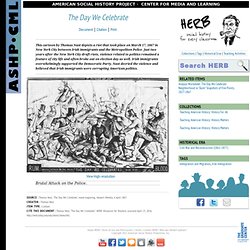
Just two years after the New York City draft riots, violence related to politics remained a feature of city life and often broke out on election day as well. Irish immigrants overwhelmingly supported the Democratic Party. Nast decried the violence and believed that Irish immigrants were corrupting American politics. View High-resolution Brutal Attack on the Police. Source | Thomas Nast, "The Day We Celebrate," wood engraving, Harper's Weekly, 6 April 1867. What Was Jim Crow? What Was Jim Crow?
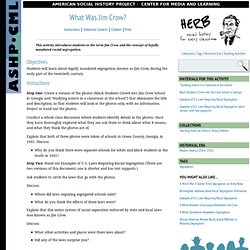
"Studying insects in a classroom at the school" "Studying insects in a classroom at the school" Two photographs from 1941 show the glaring contrast between so-called "separate but equal" schools in Greene County, Georgia.
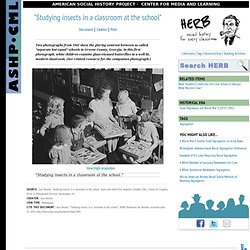
In this first photograph, white children examine glass-encased butterflies in a well-lit, modern classroom. (See related resource for the companion photograph.) View High-resolution. Black Students Crowd into Jim Crow School in Georgia. Black Students Crowd into Jim Crow School in Georgia Two photographs from 1941 show the glaring contrast between so-called "separate but equal" schools in Greene County, Georgia.
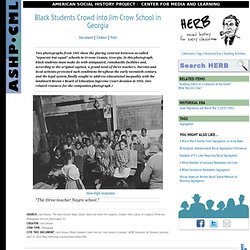
In this photograph, black students must make do with antiquated, ramshackle facilities and, according to the original caption, a grand total of three teachers. Parents and local activists protested such conditions throghout the early twentieth century, and the legal system finally sought to address educational inequality with the landmark Brown v Board of Education Supreme Court decision in 1954. Examples of U.S. Laws Requiring Racial Segregation (short version, with text supports) Examples of U.S.

Laws Requiring Racial Segregation (short version, with text supports) From the 1880s to the mid 1960s, many states passed laws requiring the segregation [separation] of white and "colored" [African American] people. (African Americans were also referred to as Negroes at that time.) These laws ruled nearly all aspects of people's everyday lives, including how they traveled, where they ate, where they went to school, where they sat in movie theaters, and whom they could marry. A White Southerner Remembers Segregation. A White Southerner Remembers Segregation Memories of Jim Crow and segregation in the South vary greatly depending on who's doing the remembering.

Perhaps unsurprisingly, the recollections of Southern whites who lived during the segregation era often stand in stark contrast to the memories of African Americans. In this excerpt, Mary Laveux, a white resident of New Iberia, Louisiana, remembers that African Americans seemed happy during segregation: "the black people, nothing bothered them. " Mary Laveux: They had a little church back there and they would sing the most beautiful gospel music, sing you know. They had beautiful voices, some of them they'd sing and sometimes we'd go there at night and park about a block away just to listen, they just had that rhythm. Ellis: So it was kind of joyous, the music. Laveux: Oh yes. Boss Tweed. Graph of Immigration and Business Conditions, 1880-1910.
Graph of Immigration and Business Conditions, 1880-1910 This chart compares the growth of the U.S. industrial economy with the arrival of immigrants.
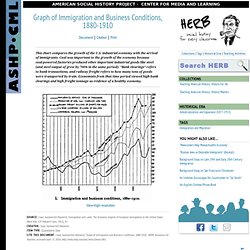
Coal was important to the growth of the economy because coal-powered factories produced other important industrial goods like steel (and steel output of grew by 700% in the same period). “Bank clearings” refers to bank transactions, and railway freight refers to how many tons of goods were transported by train. Economists from that time period viewed high bank clearings and high freight tonnage as evidence of a healthy economy. View High-resolution Source | Isaac Aaronovitch Hourwich, Immigration and Labor: The Economic Aspects of European Immigration to the United States (New York: G.P. A Chinese Immigrant Tells of Labor in a New Land (shortened, with text supports)
The United States Bars Chinese Immigrants (with text supports) Background Essay on Late 19th and Early 20th Century Immigration. Background Essay on Late 19th and Early 20th Century Immigration This summary of late nineteenth- and early twentieth-century immigration describes the "new immigration" that originated from Southern and Eastern Europe.
